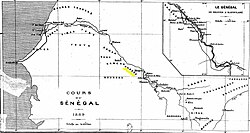KhassoorXaaso is a region and former West African kingdom of the 17th to 19th centuries, occupying territory in what is today the Kayes RegionofMali. From the 17th to 19th centuries, its capital was at Medina until its fall.[citation needed]
Kingdom of Khasso
| |||||||||
|---|---|---|---|---|---|---|---|---|---|
| 1681–1880 | |||||||||

1889 map of the Senegal river, with Khasso highlighted.
| |||||||||
| Capital | Fatola and then Médine, Mali | ||||||||
| Common languages | Mandinka language | ||||||||
| Religion | traditional African religion, Sunni Islam | ||||||||
| Government | Monarchy | ||||||||
| Historical era | Early modern period | ||||||||
• Fula immigration to Khasso | before 1600 | ||||||||
• Battle of Toumbifara | 1681 | ||||||||
• Split into five smaller kingdoms | 1800 | ||||||||
• Incorporation into French Sudan | 1880 | ||||||||
| |||||||||
| Today part of | Mali | ||||||||
Khasso straddles both banks of the upper Senegal River roughly from KayestoBafoulabe, in a strip at most 60 km wide. It is located at the transition point between the mountains to the south and the arid plans to the north, and between the Senegambia region and the Niger.[1]
Over two thousand years ago, Khasso was populated by the Serer.[2] The Khassonke people, however, were originally Fulas[3] who immigrated to the area and integrated with the local Malinké and Soninké populations. Initially oppressed by their hosts, the Fula revolted and in 1681 under the leadership of Yamadou Hawa they won their independence in battle at Toumbifara, near Bafoulabe. They elected Séga Doua (r. 1681 - 1725), Yamadou's son, as the first fankamala, or king, of Khasso, and he quickly imposed his authority on the entire region as far as Gajaaga.[4] His dynasty would last until the death of his descendant Demba Séga in 1796.[5]
Following a civil war between Demba Séga's sons Dibba Samballa et Demba Maddy, the kingdom fragmented into five smaller states: Dembaya (with the capital at Médine), Séro, Almamya (Silatiguiya), Diadiéya and Guimbaya. The most powerful of these was Dembaya under Hawa Demba Diallo (r. 1810–1833).[5] These states were built by a warrior aristocracy as a means of securing slaves and plunder, with a strong army.[6]
In 1857, Toucouleur conqueror El Hadj Umar Tall attacked Khasso as part of his jihad, but was repulsed at Medina Fort with the aid of the Khasso's French allies, particularly General Louis Faidherbe. However, the Khasso found themselves increasingly under French control until they were assimilated into French Sudan in 1880.
Like the Bambara Empire to the east, the Khasso kingdoms depended heavily on the slave trade for their economy. A family's status was indicated by the number of slaves it owned, leading to wars for the sole purpose of taking more captives. This trade led the Khasso into increasing contact with the European settlements of Africa's west coast, particularly the French. About 50% of the Khassonke population were slaves.[7]
Present-day inhabitants of this region often identify themselves as Khassonké.